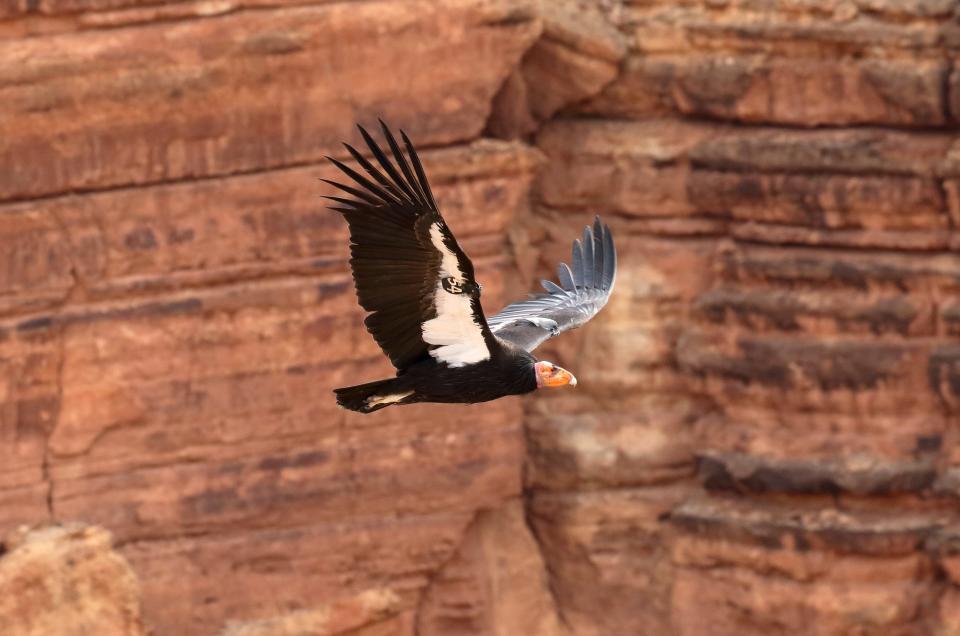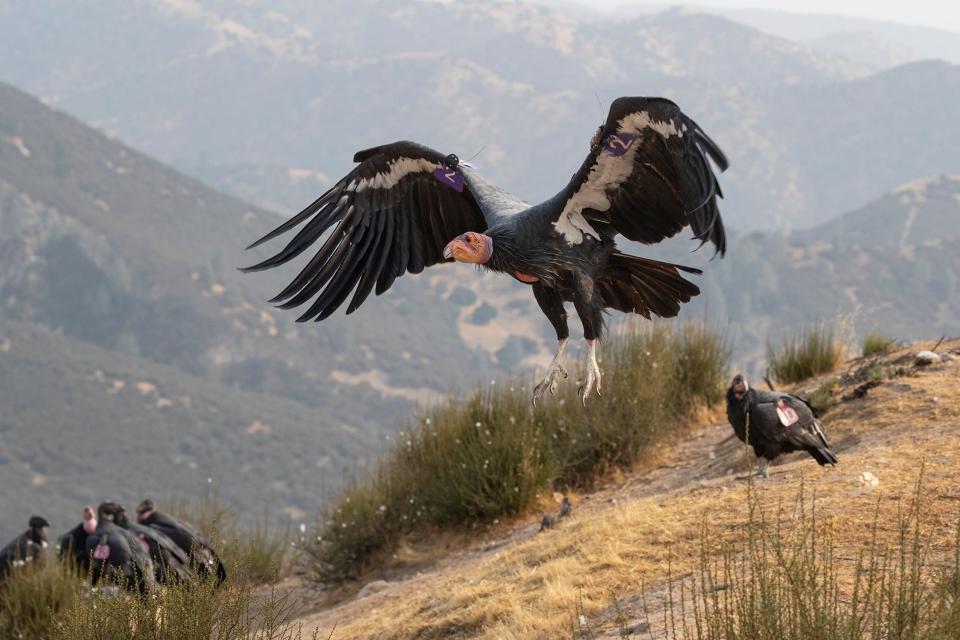Avian flu kills 10 northern Arizona condors and officials fear the virus could spread
At least 10 California condors in northern Arizona and southern Utah have died due to a strain of avian flu, and wildlife officials are worried that the recent outbreak could hurt recovery for the endangered bird and potentially spread to other condor populations.
Since March, 20 condors have died in the Arizona-Utah flock — more than 15% of the population there, some officials estimate — and half of those birds tested positive for Highly Pathogenic Avian Influenza. Four condors are still receiving supportive care and have shown improvement.
The Arizona-Utah population moves throughout northern Arizona and southern Utah, occupying the landscape within Grand Canyon National Park, Zion National Park, Vermillion Cliffs National Monument, on the Kaibab Plateau and surrounding areas. There are an estimated 116 wild condors flying over Arizona and Utah, according to the Peregrine Fund. The virus has not been detected in the other condor populations in California or Baja California, Mexico.
“The condor is slow to mature, taking up to eight years before they can produce young, and with an average of one young every other year, the rate of replacement for a loss in the wild is a big impact,” said Chris Parrish President and CEO of the Peregrine Fund, a group that manages wild populations of the bird. “Given the total number of birds we eventually lose and the age structure of those lost will have a tremendous impact on the recovery effort, likely to take decades.”
The California condor has been protected as an endangered species since 1967. By 1982 fewer than 25 condors remained in the wild until an effort was launched to capture the remaining birds and start a captive breeding program. By the late 1980s the final bird was captured, making the species extinct in the wild.
The first condor was released into the wild in 1995, and the first wild-born condor was welcomed in 2003.
Condors are slow to reproduce and have small clutch sizes, which makes recovery and reintroduction a slow process. The “thunderbirds” typically reproduce only once a year, laying one egg at a time. The slow reproduction rate coupled with a hit to wild populations will likely slow the growth rate of the species that has long faced adversity.
According to avian disease experts, it's likely that migration patterns are aiding the spread of avian flu during this current outbreak.
“There are concerns this will affect more birds,” said Stephanie Lamb, a veterinarian at Liberty Wildlife in Phoenix who is caring for the birds. “It could spread from our local population in Northern Arizona but there are concerns it will go to other flocks in California or Baja.”
Endangered birds: Condors take flight near Grand Canyon, but lead ammo could ground the species
Wildlife managers fear the spread of the flu virus

While HPAI can spread from condor to condor, a bigger concern is that other migratory birds could spread the virus to the other populations of the endangered species. Since the three condor flocks in North America are separated by hundreds of miles it is unlikely condor-to condor transmission would occur across state lines.
Avian flu is common, and historically the virus will die out after a season, but this strain has been spreading for a longer period. It has been affecting birds since last spring, and just recently made its way to the condor flock in Arizona and Utah.
Virologists are not sure why the strain is persisting longer than normal, and studies are still underway to understand the cause.
Before the recent string of deaths, only 334 condors remained in the wild, according to the National Park Service.
In March, the Peregrine Fund, which manages the Arizona-Utah condor flock, first observed a bird in the wild exhibiting signs of illness. Initially, officials believed the bird was suffering from lead poisoning, which is a leading cause of death for the bird that initially led the species to its endangered listing.
“They just weren’t acting like normal condors,” said Lamb. “They should be flying around and moving from one place to another, and a lot of individuals were just sitting there and not really moving.”
That bird was monitored until her death 11 days later. The dead bird was sent to the U.S. Fish and Wildlife Service’s Clark R. Bavin National Fish and Wildlife Forensics Laboratory for a necropsy to determine the cause of death and it was there that HPAI was confirmed.
When initially reported on April 4, a total of three dead birds had tested positive for HPAI. Since then, seven more deaths have been linked to the virus.
Wildlife in Arizona: Jaguars, leopard frogs, condors: Here are some of the state's most imperiled species
Infected birds are brought to a wildlife rehab center

Crews are continuing to monitor both health and behavior to identify symptomatic birds. Sick and distressed birds are being sent to Liberty Wildlife in Phoenix, with eight brought in so far.
When a bird first arrives, it undergoes several diagnostic tests to assess its health and is tested for HPAI.
“We're testing for infectious disease, toxins, and organ functions,” said Lamb. “And then depending on what the individual looks like they will go into different areas of care.”
She says some of the sick birds brought in were also underweight and “quiet,” but were not exhibiting other symptoms expected of a bird with avian flu, such as fecal discharge or vomiting.
Once symptoms appear to resolve, the bird is retested and if found to be negative will be moved to a post-quarantine holding area to await another negative test before they are approved to go with known negative birds.
The team is working to get the birds strong and healthy enough for a release back into the wild.
“The hope is that they will be able to go back into the wild,” Lamb said. “We want to get these birds through this and get them back out into the wild to live their lives the way they are meant to.”
Helping species thrive: Even the hardy desert tortoise needs help as the Earth warms and habitat disappears
This virus is likely to become endemic in bird populations. Officials are looking toward long-term conservation strategies for limiting the spread of HPAI in additional populations and protecting captive birds.
“We will need to double down on causes of mortality that we can control or change rates of like lead poisoning to be better prepared,” said Parrish. “Hopefully, vaccines and greater infrastructure to respond to events like this in the future.”
Lamb says recovering from this strain of flu will likely take a few years, but she is optimistic that the bird that has recovered from extinction-in-wild will prove resilient.
“Fifteen percent is a good chunk, but we can recover,” said Lamb. “It’s going to take a little bit of time to get back to the number where we were, but we will get there as long as we don’t take much more hits.”
Jake Frederico covers environmental issues for The Arizona Republic and azcentral. Send tips or questions to jake.frederico@arizonarepublic.com.
Environmental coverage on azcentral.com and in The Arizona Republic is supported by a grant from the Nina Mason Pulliam Charitable Trust. Follow The Republic environmental reporting team at environment.azcentral.com and @azcenvironment on Facebook, Twitter and Instagram.
You can support environmental journalism in Arizona by subscribing to azcentral today.
This article originally appeared on Arizona Republic: Avian flu strain kills 10 condors and officials fear more will die

